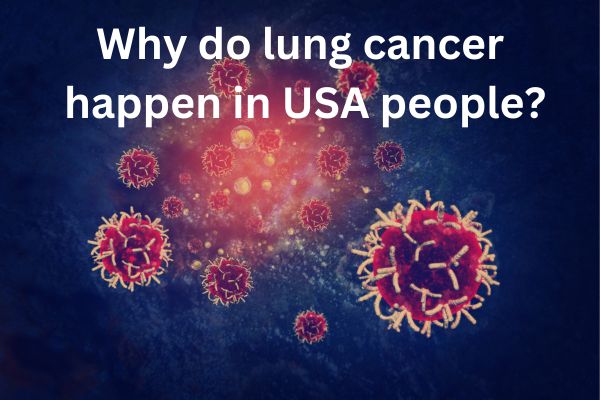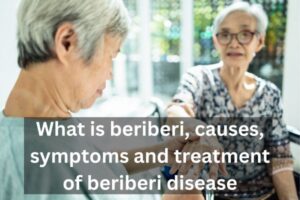Understanding Lung Cancer: A Comprehensive Guide on why does lung cancer happen in USA people?
You will come to know in this blog that why does lung cancer happen in USA people? Lung cancer is one of the most common and serious types of cancer, affecting millions of people worldwide, including a significant number of Americans each year. This comprehensive guide aims to delve into why lung cancer happens, who it affects the most, its symptoms, and various preventive measures. We’ll also explore the levels and types of lung cancer, the role of yoga and workouts, healthy and unhealthy foods, top hospitals, and specific tips for men and women. By understanding these aspects, we can take proactive steps towards better lung health.

Why Lung Cancer Happens in Americans?
Lung cancer occurs due to a combination of genetic, lifestyle, and environmental factors. Here are some of the primary reasons:
- Smoking: The leading cause of lung cancer is cigarette smoking, which accounts for approximately 85% of all lung cancer cases. The carcinogens in tobacco smoke damage the cells in the lungs, leading to cancer.
- Secondhand Smoke: Non-smokers exposed to secondhand smoke also have an increased risk of developing lung cancer.
- Radon Gas: Radon is a naturally occurring radioactive gas that can accumulate in homes and buildings. Long-term exposure to high levels of radon can increase the risk of lung cancer.
- Asbestos and Other Carcinogens: Occupational exposure to asbestos, arsenic, chromium, nickel, and other carcinogens can lead to lung cancer.
- Air Pollution: Long-term exposure to polluted air, including fine particulate matter, can contribute to lung cancer risk.
- Genetics: A family history of lung cancer can increase an individual’s risk, indicating a potential genetic predisposition.
- Personal History: Previous radiation therapy to the chest and other lung diseases such as chronic obstructive pulmonary disease (COPD) can increase the risk of lung cancer. You come to know that why does lung cancer happen in USA people?
Who is Most Affected?
Lung cancer can affect anyone, but certain groups are at a higher risk:
- Smokers: Both current and former smokers are at a significantly higher risk of lung cancer compared to non-smokers.
- Older Adults: The risk of lung cancer increases with age, with most cases diagnosed in people aged 65 and older.
- Men: Historically, men have been more likely to develop lung cancer, although the gap is narrowing as smoking rates among women increase.
- People with Occupational Exposure: Individuals exposed to carcinogens in their workplace are at higher risk.
- Individuals with a Family History: A family history of lung cancer increases the likelihood of developing the disease. Now you came to know that and who is mostly affected why does lung cancer happen in USA people?
Symptoms of Lung Cancer
Lung cancer symptoms can vary depending on the type and stage of the disease. Common symptoms include:
- Persistent Cough: A cough that does not go away or worsens over time.
- Coughing Up Blood: Hemoptysis, or coughing up blood, can be a sign of lung cancer.
- Shortness of Breath: Difficulty breathing or shortness of breath.
- Chest Pain: Persistent chest pain that may worsen with deep breathing, coughing, or laughing.
- Hoarseness: Changes in voice or hoarseness.
- Weight Loss: Unexplained weight loss and loss of appetite.
- Fatigue: Persistent fatigue or weakness.
- Frequent Infections: Recurrent infections such as bronchitis or pneumonia.
- Bone Pain: Pain in the bones, which may indicate metastasis.
Precautions at Home
- Avoid Smoking: Do not start smoking, and if you do smoke, seek help to quit.
- Reduce Radon Exposure: Test your home for radon and take steps to reduce high levels if detected.
- Avoid Secondhand Smoke: Ensure that your home and workplace are smoke-free environments.
- Healthy Diet: Eat a balanced diet rich in fruits, vegetables, and whole grains.
- Regular Exercise: Engage in regular physical activity to maintain overall health.
- Air Quality: Use air purifiers and ensure proper ventilation in your home to reduce exposure to pollutants.
Do's and Don'ts
Do’s:
- Regular Screening: If you are at high risk, consider regular lung cancer screening with low-dose CT scans.
- Healthy Lifestyle: Maintain a healthy diet and exercise regularly.
- Avoid Carcinogens: Limit exposure to known carcinogens, both at home and in the workplace.
- Monitor Symptoms: Be aware of and report any persistent symptoms to your healthcare provider.
- Stay Hydrated: Drink plenty of water throughout the day.
Don’ts:
- Don’t Smoke: Avoid tobacco products completely.
- Don’t Ignore Symptoms: Seek medical attention if you experience symptoms of lung cancer.
- Don’t Neglect Air Quality: Ensure your living and working environments have good air quality.
- Don’t Rely on Supplements: While vitamins and supplements can support health, they should not replace a balanced diet.
- Don’t Lead a Sedentary Lifestyle: Engage in regular physical activity and avoid prolonged periods of inactivity. Now you come to know that why does lung cancer happen in USA people?
How to Avoid Lung Cancer?
- Quit Smoking: If you smoke, quitting is the most effective way to reduce your risk of lung cancer.
- Avoid Secondhand Smoke: Ensure that your environments are smoke-free.
- Test for Radon: Regularly test your home for radon and mitigate if necessary.
- Use Protective Equipment: If you work with hazardous materials, use appropriate protective equipment.
- Healthy Diet: Eat a balanced diet rich in antioxidants, vitamins, and minerals.
- Exercise Regularly: Maintain a routine of regular physical activity.
- Avoid Air Pollution: Minimize exposure to outdoor air pollution when possible. Why does lung cancer happen in USA people?
Levels and Types of Lung Cancer
Levels of Lung Cancer: Why does lung cancer happen in USA people?
- Stage I: Cancer is localized and has not spread to lymph nodes.
- Stage II: Cancer has spread to nearby lymph nodes or structures.
- Stage III: Cancer has spread further into the chest and lymph nodes.
- Stage IV: Cancer has spread to other parts of the body (metastasis).
Types of Lung Cancer:
- Non-Small Cell Lung Cancer (NSCLC): The most common type, accounting for about 85% of cases. It includes subtypes such as adenocarcinoma, squamous cell carcinoma, and large cell carcinoma.
- Small Cell Lung Cancer (SCLC): Less common but more aggressive, often spreading quickly to other parts of the body.
- Lung Carcinoid Tumor: Rare, slow-growing tumors that account for a small percentage of lung cancers.
Yoga and Workouts for Lung Cancer
Yoga:
- Pranayama (Breathing Exercises): Techniques such as Anulom Vilom (Alternate Nostril Breathing) and Kapalbhati (Skull Shining Breath) improve lung capacity and oxygenation.
- Gentle Asanas: Poses like Savasana (Corpse Pose), Balasana (Child’s Pose), and Sukhasana (Easy Pose) promote relaxation and reduce stress.
Workouts:
- Walking: Low-impact exercise that helps maintain overall health and lung function.
- Swimming: A full-body workout that is gentle on the joints and improves cardiovascular health.
- Strength Training: Light weightlifting to maintain muscle mass and strength.
- Stretching: Regular stretching exercises to maintain flexibility and relieve tension.
Healthy Foods for Lung Cancer
- Fruits and Vegetables: Rich in antioxidants, vitamins, and minerals. Examples include berries, leafy greens, carrots, and tomatoes.
- Whole Grains: Sources like oats, quinoa, and brown rice provide essential nutrients and fiber.
- Lean Proteins: Chicken, fish, beans, and legumes support muscle maintenance and overall health.
- Nuts and Seeds: Almonds, walnuts, chia seeds, and flaxseeds are good sources of healthy fats and nutrients.
- Healthy Fats: Avocados, olive oil, and fatty fish like salmon provide omega-3 fatty acids.
Foods to Avoid
- Processed Foods: High in unhealthy fats, sugar, and sodium.
- Sugary Beverages: Soft drinks and sweetened juices.
- Red Meat: High consumption can be linked to increased cancer risk.
- Fried Foods: Contain unhealthy trans fats.
- High-Sodium Foods: Processed snacks, canned soups, and fast food.
- Alcohol: Excessive consumption is linked to increased cancer risk.
Best Hospitals for Lung Cancer in America
- Mayo Clinic (Rochester, MN): Known for comprehensive cancer care and advanced treatment options.
- MD Anderson Cancer Center (Houston, TX): A leader in cancer research and treatment.
- Cleveland Clinic (Cleveland, OH): Offers cutting-edge treatment and personalized care.
- Johns Hopkins Hospital (Baltimore, MD): Renowned for its innovative lung cancer treatments.
- Memorial Sloan Kettering Cancer Center (New York, NY): Specializes in cancer care and research.
Tips for Men and Women
For Men:
- Regular Screening: High-risk individuals should consider regular lung cancer screening.
- Healthy Lifestyle: Maintain a healthy diet and exercise routine.
- Avoid Carcinogens: Limit exposure to known carcinogens in the workplace and environment.
- Stress Management: Practice stress-reducing techniques like meditation and deep breathing.
For Women:
- Know the Symptoms: Be aware of lung cancer symptoms and report any persistent issues.
- Healthy Lifestyle: Follow a balanced diet and engage in regular physical activity.
- Avoid Smoking: Women should avoid tobacco products and secondhand smoke.
- Seek Support: Join support groups or counseling if needed to cope with diagnosis and treatment.
When to See a Doctor
- Persistent Cough: If you have a cough that does not go away or worsens over time.
- Coughing Up Blood: Any instance of coughing up blood should be evaluated immediately.
- Shortness of Breath: Difficulty breathing or shortness of breath requires medical attention.
- Unexplained Symptoms: Any new, unusual, or worsening symptoms should be checked by a doctor.
- Regular Screenings: High-risk individuals should have regular screenings for early detection.
Conclusion
Lung cancer is a significant health concern in the United States, but with the right knowledge and proactive measures, it can be managed and even prevented. By understanding the causes, symptoms, and preventative strategies, and by incorporating healthy habits into daily life, Americans can reduce their risk and improve their lung health. Regular check-ups, a balanced diet, physical activity, and avoiding known carcinogens are key components in the fight against lung cancer. Remember, taking care of your lungs today will lead to a healthier and longer life tomorrow. Now you came to know in this blog that why does lung cancer happen in USA people?






